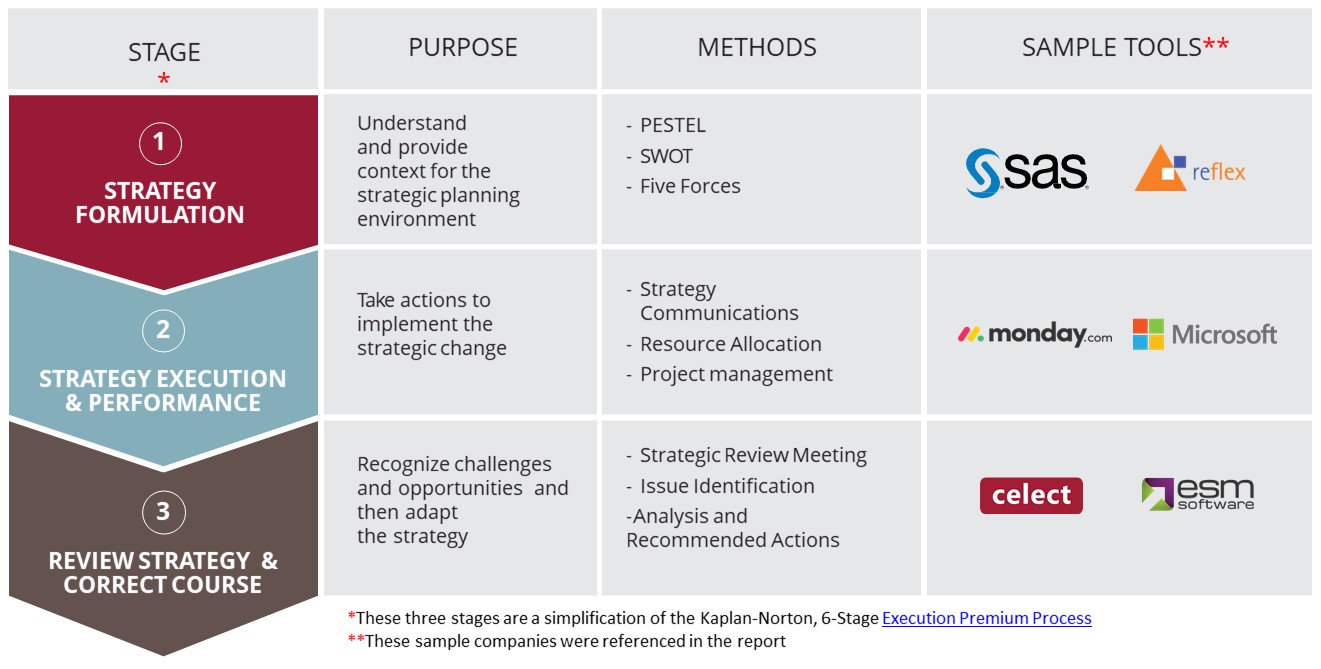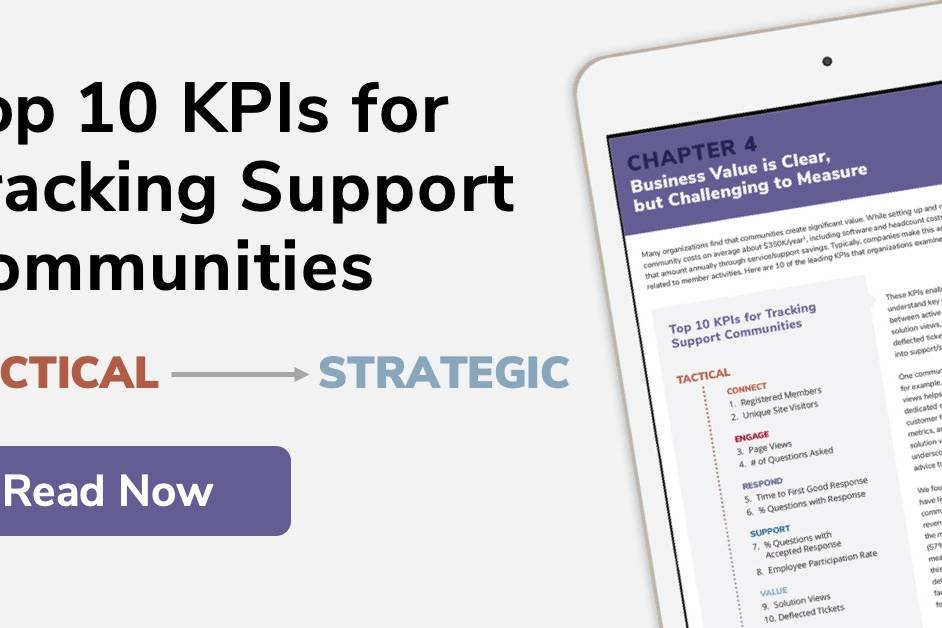By Mario Bognanno, Randall Russell and Adam Zawel
Introduction
According to Peter Weill[1], only about 24% of boards of directors are “digitally savvy.” But such firms enjoy 38% higher revenue growth, and 34% higher market cap growth compared to non-digitally savvy firms.
During the past twenty years we have worked with scores of organizations around the world to help them plan, execute, and review their strategies. Over these years we have witnessed the adoption of new technologies for strategy planning and execution. While strategy management remains a largely human-based process, it is one that can be enriched using digital tools.
In this article, we explore the ways in which digital technologies are being used to enhance the strategy management processes of strategy design, execution, and review. We assess how new and emerging digital tools, combined with traditional strategy management processes, can yield advantages to those savvy enough to leverage this powerful combination.
Strategy Management Process #1—Strategy Planning
Strategic planning, defined as establishing the strategic vision (3-5 years out) and defining the objectives that must be achieved to realize the strategic vision, is the initial strategy management process. The strategy planning process can include traditional approaches such as: PESTEL analysis (used to examine the external marketing environment), SWOT analysis (to examine the relationship between internal capabilities and the external environment), and Five Forces analysis as popularized by Michael Porter, among other approaches.
Digital tools can greatly enrich each of these analyses, enabling stronger, more comprehensive, and more valuable insights. For example, ESM Software, technology that helps teams design and execute their strategic plans through balanced scorecard software, offers tools to support Five Forces, PESTEL and SWOT analyses, thus making it easier to get started with these forms of analysis. ESM is just one of a number of providers that offer tools to support the strategy management processes. If you’re not already familiar with this market segment, we recommend you take a look.
Digital tools also allow the digitally astute planner to more accurately predict future market opportunities and assess the potential return that will be generated by new investments. For example, new tools are being used to forecast consumer preferences. Rather than ask likely consumers what they think they might like, these digital tools allow strategy planners to examine real-time behavior in order to predict market dynamics. Through the use of these resources, strategy leaders can generate more accurate estimates of how specific segments will behave in response to new product offerings and forecast how specific segments are likely to evolve. Combining real-time data with simulation tools allows strategic planners to anticipate consumer behavior in response to modifications to existing products and services and in response to new offerings that don’t yet exist.
CASE EXAMPLE—Booths’ Use of RELEX
Today’s vendors of forecasting tools are creating new solutions that combine analytic tools, AI, and data mining techniques to accurately estimate future consumer behavior. CIO Review is a popular trade magazine that reviews such tools. RELEX is an example of a next generation tool identified by CIO Review as one of the best of breed used in the retail industry[2].
Booths, a leading regional supermarket chain in England, successfully used RELEX’s demand forecasting tool to address several strategic challenges it was facing: becoming differentiated as a destination retailer, better managing the impact of seasonality and weather on consumer behavior, and improving its reputation for product and service quality[3]. Booths believed that improved demand forecasting would allow it to take better account of weather, improve planning for product introductions, ensure optimal allocations to stores, and move staff toward more value-adding managerial tasks.
At Booths, the use of RELEX provided measurable benefits: it resulted in a 20% reduction in spoilage of fresh food products and a 10% reduction in spoilage across all products, which was a direct realization of their strategic objective to reduce wastage. This significant outcome was a direct result of the digital tool – RELEX – that Booths invested in. As a result of implementing RELEX, Booths is now able to more accurately forecast consumer demands, driving down costs and improving efficiency.
CASE EXAMPLE—Chubb Insurance’s Use of SAS
Chubb Insurance’s use of SAS further indicates the value of digital tools. Today’s insurers are creating specialized products to meet the individual needs of art collectors, owners of midsize businesses and professionals in particular industries. The demand for specialized policies is on the rise, and the key to marketing and selling them lies in the ability to segment customer data at ever-finer levels.
Chubb Insurance used SAS’ business intelligence tools to perform market segmentation and market assessment. According to Jeff Hoffman, Senior Vice President, Market Planning and Performance at Chubb:
“SAS helps us from a strategic standpoint in identifying the strength of our distribution within a specific territory and determining segments as targets within a specific region, state or county.”
Digital technology enables this advanced segmentation. With digital tools, Chubb staff was able to combine and analyze data from internal and external sources, including demographic census data, corporate data from Dun & Bradstreet, customized industry data from MarketStance, and historical underwriting and claims data. These digital instruments enhance strategy planning with the ability to better understand narrow customer segments.
KEY TAKEAWAY—
New digital tools are providing analytical abilities that offer advantages in strategy formulation. New tools provide insights that allow micro-segmentation and shorter response times, improving the ability of the organization to succeed in the long term. Digitally savvy organizations will find it useful to explore such tools as part of their strategy formulation process.
Strategy Management Process #2— Execute Strategy and Drive Performance
After strategy planning, the next strategy management process is to execute the planned strategy. Strategic initiatives—new investments that introduce new processes or that modify existing processes—are used to execute the strategy. How can new digital technologies improve the strategy’s execution?
Too often organizations have a beautifully crafted strategy but, tragically, it is never executed; Instead, it sits in a binder and gathers dust on a shelf. In order for a strategy to be executed effectively, the people in the organization need to be inspired by the strategy to act, and departments must be “aligned” with the strategy so the optimal sequence of actions is put in place. Also, resources must be allocated to enable the strategic initiatives that were identified in the planning phase. Strategy execution is about change: changing attitudes, changing processes, and launching initiatives that will allow the organization to achieve its desired strategic objectives which constitute the strategy.
Digital technologies can help accelerate the changes required to execute strategy. Often, the introduction of a digital technology itself helps to initiate the desired changes. For example, if the objective is to improve employee morale and engage remote teams, then the launch of an Enterprise Social Network can immediately start serving these purposes. Similarly, if the strategy is to become more digital, the use of digital technologies internally or externally will communicate the strategy.
But how can digital technologies assist in the execution of non-technological strategic objectives? One way that digital tools can help these strategies is by providing a medium for connection between different organizational departments. Almost any new strategy will require a set of funded strategic initiatives. These initiatives are typically big projects, and projects are often managed with project management software.
Both small digital tool start-ups and large enterprise software vendors (e.g. IBM and Microsoft) are integrating social collaboration features into their project management software offerings. As a result, it is possible to provide greater visibility across the enterprise into all projects. In theory, everyone can now know what everyone else is doing. This enables the creation of a culture of “working out loud.”
Gartner includes these types of solutions in a category called “social software in the workplace.” The focus of these solutions is to improve operations; to improve teamwork on a real-time, 24/7, basis. We believe that the leaders of strategic initiatives can and should utilize this social software to help achieve their strategic objectives.
CASE EXAMPLE—Wix’s Use of Monday.com
Monday.com (a start-up valued at $500 million) provides “a new way to manage your work”. It is a collaboration and communication application for teams that synchronizes information in a single, accessible hub, empowering team members to make important decisions together. We know from our strategy consulting work that many strategy leaders struggle to differentiate between “strategic” and everyday tactical initiatives, and to manage strategic initiatives with extra vigor. The new software can help by providing greater visibility into initiative status and resource requirements. It can also help strategy managers manage strategic initiatives as a portfolio.
This social software for the workplace helps everyone in the organization have great visibility. Everyone can see what everyone else is doing. There is a new culture of “working out loud”. Here’s how Wix, one Monday’s clients, describes the impact as Wix grew from a small to a mid-sized company[4]:
“We had crazy growth as a company. We went from 50 employees to over 1000 within a couple of years. This was incredible, but of course it came with growing pains. We had no idea what anyone else was doing, we spent way too much time in meetings and had no way of communicating properly. I also really needed to maintain the culture we had as a small team where people feel constantly excited and valued.”
CASE EXAMPLE—HubSpot’s Use of Slack
Slack is a widely used social software tool in organizations. Slack doesn’t specifically help with project management; it’s more of communication tool, an evolution of instant messaging and email. As with email or public social media, Slack can be used to spread “noise” around the organization. But it can also be used to execute strategies quickly.
HubSpot[5], one of Slack’s customers, had a strategic objective to increase international sales. HubSpot used Slack’s powerful integration capabilities (linking CRM data to the social channel), so that insights about customer wins were promoted, shared and discussed in real-time. By configuring the Slack integration to focus the team collaboration specifically on international sales wins, the sales team focused their attention on what was strategically important.
The published case study describes how this worked technically:
“. . . a custom Slack integration . . . allows users to create new HubSpot tasks, receive notifications, and search contacts right from Slack. Without the constant context-switching, the sales team can spend their time on more valuable activities, like knowledge sharing.”
The HubSpot Senior Vice President responsible for increasing international sales added:
“Anytime we win a new customer, we send a message to a Slack channel where we share details about who the customer is, why they bought, and how we helped solve their pain points. Those learnings have been really important for all of our sales reps globally.”
KEY TAKEAWAY—
Strategy leaders can utilize project management and social software for greater impact, both for digital and non-digital strategy implementation. Technology vendors should consider the untapped potential of their solutions and define configurations that make it easier for strategy leaders to implement and, in-so-doing, better enable strategy execution.
Strategy Management Process #3 – Review Strategy and Make Course Corrections
The final stage of strategy management is the review process. Assessing a new strategy’s performance post-launch is critical because it reveals how well the company is doing in achieving strategic results; in addition, the review sets the stage for the next planning cycle. Feedback on performance is generated both as the initiatives are rolled out and as the initiatives begin to produce results. Performance feedback is used to make minor strategy corrections over the short run. As time passes, and as the feedback on results continues to accumulate, it is important to develop an internal competency to assess the feedback and determine whether the mid-term and long-term targets are going to be met.
It’s always possible that the hypotheses used to formulate the strategy are not correct. It’s also possible that the strategic initiatives that have been implemented are appropriate for the prevailing market conditions but will simply take longer to achieve the desired results than the planners estimated. In addition, it’s conceivable that something is missing from the set of initiatives or that the market conditions are not shaping up the way the planners had forecast. Over the first few quarters during which a new strategy is implemented (or over the first few weeks in more dynamic market environments), strategies must be monitored and reviewed to determine the need for course corrections. Digital tools can assist in this surveillance.
CASE EXAMPLE—Agria Insurance’s Use of SAS
Agria is a Swedish insurance company that provides health, life and liability insurance for pets and farm animals. The insurer competes in Sweden, Norway, Denmark, Finland, France and Great Britain, and is a subsidiary of a Swedish mutual insurance company.
Agria uses SAS Studio and SAS Visual Analytics to calculate pricing and risk factors for its insurance products, as well as for marketing and communications. To further champion the health of animals, the company also uses its vast amounts of data to provide statistics on the health of different animal breeds to scientists, veterinarians and breed associations.
“Our mission is to promote best of care for the animals and peace of mind for their owners,” says Peter Nord Andersson, Head of Pricing and Analytics at Agria. “We believe that through better animal welfare, we get healthier pets. We provide our data to breeders, researchers and veterinarians to help understand illnesses and breeding-related health issues. We also donate part of our income to further research in animal welfare.”
Agria relies on SAS tools to formulate its strategy for calculations of risk analysis, pricing, and market development. It is able to gain insights so that people from sales, product development and market surveillance can access a wealth of reports to see both high-level trends and detailed information—down to a specific dog and its product suite. And at the back end of the strategy execution process, Agria is able to assess its overall impact on the population of the owners and animals it serves by reviewing the overall health changes that are occurring in the health of the animals.
CASE EXAMPLE—Nike’s Acquisition of Celect
Not only do corporations use digital tools to enable strategy review, the digital tools themselves can become a strategy through acquisitions. For example, Nike recently acquired the firm Celect[6], which provides Nike with retail predictive analytics and demand sensing capabilities to better serve consumers personally at a global scale.
According to executives at Nike,
“As demand for our product grows, we must be insight-driven, data optimized and hyper-focused on consumer behavior. This is how we (will) serve consumers more personally at scale.”
Nike wanted to do a better job of sensing changes in customer preferences. As they sensed changes taking place in their consumers’ needs and desires, they needed to make changes to the production cycle that included changes in the design of products, changes in the manufacturing cycle, as well as changes in where and when new products are made available. Data integration was a key challenge since it would drive all of these changes. Similarly, data would drive changes to the strategy management process that would be used to update the short- and mid-term plans, execute the plan, and set the stage for the next round of strategy updates.
Given Nike’s size and strategic ambition it’s not surprising to learn that they didn’t just use the capabilities that Celect provides. They acquired the firm itself! Celect’s key employees are all tenured professors at MIT, and one can safely assume that this acquisition provides key short- and mid-term advantages that their competitors will struggle to imitate. The lesson for others—in the sports gear market and elsewhere—is that the challenge of aligning digital capabilities with strategy is becoming evermore intense.
KEY TAKEAWAY—
Reviewing the performance of your strategic initiatives is imperative in ensuring that the company is on the right path and that your objectives will be realized, and digital tools can help. Statistical packages such as SAS and SPSS can be used to perform rigorous testing of your strategic hypotheses. Acquisitions of newer tools, such as the capabilities represented by Celect, allow companies to develop a strong competitive advantage in their industries and go beyond these more traditional capabilities to create even more dynamic market results.
Summary and Conclusions: Align Your Strategy with Digital Savviness
Strategy planning (process #1) remains a largely human-based activity, but even traditional strategy planning approaches such as PESTEL, SWOT and Five Forces can be enhanced through the use of newer digital tools. Leading companies are using advanced analytics and forecasting abilities not only in operations but also for strategy planning.
Strategy execution (process #2) is enhanced by a new class of social software and employee collaboration tools. These tools can be used to powerfully communicate the strategy (and avoid dilution of the message). As global teams “work out loud”, strategy managers can take advantage of the transparency to better manage strategic initiatives.
Strategy review (process #3) has always been an analytical challenge, but digital tools can help. These tools can enable testing of hypotheses and the review of results against a data-proven benchmark. Tools that enable the strategic evaluation of executed strategies can also become a competitive advantage in their own right, enabling a wide pathway forward for companies who successfully leverage them.
After witnessing digital tool adoption among hundreds of companies for over 20 years, we give the following advice to strategy leaders: Review your cache of digital technologies and assess them in the context of your existing and planned strategy management processes. You may be able to quickly configure existing tools to provide value for your strategic processes. Acquire new capabilities based on a clear understanding of which strategy management processes they are intended to support. Be sure to anticipate the organizational capabilities (culture, training, support) that need to be in place to take full advantage of the digital aids.
For tech companies: We reviewed many of your cases studies and there is often little mention of how your offerings can be used to support the key strategy management processes. You should make it easier for strategy leaders to recognize the potential of your solutions. Increase your own experimentation with strategy management so you can share your own learnings with your clients. Your digitally savvy customers are eager to combine your tools with their own approaches to strategy management, and they are already hard at work on this integration opportunity.
When strategy leaders and tech companies understand the benefits that technology can bring at each stage of the strategy management process, digital tools can enable unprecedented success. The key is understanding where they can provide value and what insight these tools can enable.
[1] See Peter Weill research presented at the MIT CIO Symposium May 22, 2019 (https://www.mitcio.com/panel/peter-weill-town-hall/)
[2] See https://demand-forecasting.cioreview.com/vendors/top-10-demand-forecasting-tech-companies-2018.html
[3] See https://www.relexsolutions.com/case-booths-quality-and-freshness-keep-big-supermarket-rivals-at-bay/
[4] See https://www.enable.services/resources/case-studies/wix
[5] See https://slack.com/intl/en-il/customer-stories/hubspot
[6] See https://news.nike.com/news/nike-celect-acquisition
Warning: Attempt to read property "base" on array in /home3/trusten9/public_html/leadernetworks/wp-content/plugins/wp-user-profile-avatar/shortcodes/wp-user-profile-avatar-shortcodes.php on line 665
Warning: Attempt to read property "base" on array in /home3/trusten9/public_html/leadernetworks/wp-content/plugins/wp-user-profile-avatar/shortcodes/wp-user-profile-avatar-shortcodes.php on line 665
Warning: Attempt to read property "base" on array in /home3/trusten9/public_html/leadernetworks/wp-content/plugins/wp-user-profile-avatar/shortcodes/wp-user-profile-avatar-shortcodes.php on line 665
Warning: Attempt to read property "base" on array in /home3/trusten9/public_html/leadernetworks/wp-content/plugins/wp-user-profile-avatar/shortcodes/wp-user-profile-avatar-shortcodes.php on line 665
1 Comment
Add comment Cancel reply
This site uses Akismet to reduce spam. Learn how your comment data is processed.




[…] Source: https://www.leadernetworks.com/2020/03/can-effective-strategies-be-enhanced-with-digital-technologi… […]